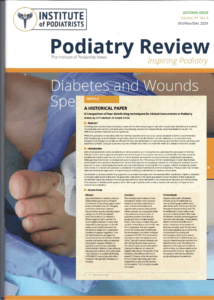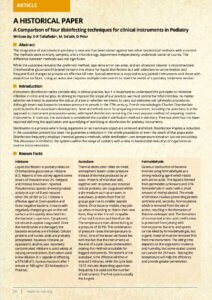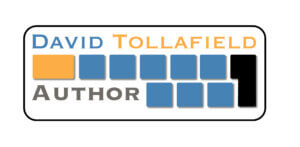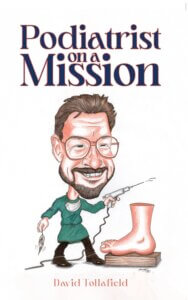Why should we write? Why should we publish?
The autoclave – how and why did we change?
I have always followed a mantra that espouses the view that ‘if it is not written down, it never happened‘. Professional writing leads to publishing in academic circles. This story is a little different—
“At the time [1978] research in chiropody was rather sparse, poorly owing to the lack of a foundation degree. In one paper from a US doctor [DPM], there was extensive material covering bacteria recovered from surgical infections. This left me in awe of their academic standards and only heightened my ambition to become a podiatrist.
Back at Weston Favell clinic, I bumped into April Reilly, the sister who ran the GP’s clinic. ‘I see you’ve got your own autoclave now. You won’t be needing mine anymore is that right? She said in jest.
I just smiled and said, ‘Anyway, not sure if you’ve heard, but Luuk has just promoted me after a year. Not bad eh’ I exuded happiness in sharing my the news.” Taken From Podiatrist On A Mission. (P67). Published initially in 2021 & then with Austin McCauley 2024.

The original cover (centre) for ‘Mission’ was replaced a year later. The new cover can be viewed at the end of the article.
‘Dettol kills all known germs, ‘ or 99% of germs,’ has been advertised in the past. However, if that 1% happened to be virulent and resistant to what we know is disinfection, then the effect, if taken into the body, could be devastating.
Autoclaves are now standard in podiatry practice, and the Institute of Podiatrists‘ training for foot health practitioners requires practical knowledge of instrument sterilisation. The autoclave, mentioned in the autobiographical novel, was all too true—it remained unused and unjustified, although the manager knew it was good.
Back in 1978
Aged 22, having no idea how to conduct research, Margaret De-Ath, the local scientific officer, and her manager agreed to my first project. She would allow me to take samples to culture our instruments taken from the clinic. These were the days before podiatry was formulated and when podiatry implied surgery. The use of pathology laboratories in hospitals was limited. Although I leaned on my science A levels, which I had, in fact, gloriously failed, this was not to be wasted on my career.
The report used our Little Sister autoclave, which was purchased for nail surgery alone. As a young maverick, I had been impressed by my new dental colleagues working on the top floor of Weston Favell and felt we should follow their protocol for routine instruments. The report was mopped up, and Northamptonshire Health Authority’s Chiropody department bid to install autoclaves in every clinic over the next few years. We were not necessarily the first but the first to use scientific evidence in the NHS. Before the manager grades commenced, I was elevated to a senior I*, the higher clinical grade, although I was offered the post of Chief IV at the time (the lowest manager rung), I turned it down as my heart was on clinical work.
*Whitley Grades existed before Agenda for Change (AFC).
After the Report
What do you do when you write a thesis?
You publish it. I approached the newly formed Podiatry Association (1975) and was turned down as it was not good enough because it required writing in a specific format. This was a fair comment, except no one offered me any advice. Bear in mind that without a degree, we had little understanding of writing a project as we would now. I submitted to The Chiropodist, an A5 journal run by the Society of Chiropodists. Nice words of encouragement but no advice! In 2018, with some spare time, having just retired from mainstream clinical work, now armed with two fellowships and two post-qualification degrees, I wrote the paper from the report with little effort (publications).
Final Publication – Podiatry Review
In 2023, I submitted my original paper (not the report) to the editor of Podiatry Review, and he was delighted to publish this from 45 years ago in October 2024. It is hardly cutting-edge by today’s standards, but it reminds us we must provide evidence even if this may not say what we want. The Null hypothesis removes immediate assumptions. An orthopaedic surgeon I befriended and examined together during the final year course at the newly formed Nene College (now Northampton University) said that most published papers weren’t worth reading. He was not suggesting that papers had little value but that assumptions could be narrow and that what a paper might tell us is very little or informs us about something we already know. Cynism aside, we need to test questions, and assuming a negative is akin to saying we shouldn’t believe the data until proven. It is a question of showing us that data is reliable, so we apply statistics to understand whether data represents the population under study.


Dr M Prior provided my statistics, such as the simple Chi Test. But what did the paper achieve? Download the 2018 paper. Comparison of four disinfecting techniques for clinical instruments in Podiatry. Tollafield, DR, De’ath, M, Prior, D Reflective Podiatric Practice. BPCC Ltd 2018,1(9-2):6-12 Comparison of disinfection techniques.
Justification Remains Important
- The manager showed his department had taken a research interest.
- Autoclaves could be justified despite their cost and need for servicing – against liquid disinfection. The report showed the costs. Sometimes, more expensive is safer.
- AIDS had just been discovered, and hepatitis B followed – two angry infections for society and hospitals to manage. Could a department fail to realise that removing all bacteria was important?
- While disinfection with hibitane (chlorhexidine) was still successful, the report and paper did show that inadequate preparation could lead to failure in the autoclave technique. Ultrasonic cleaning and washing were added to the autoclave technique due to our learning.
Epitaph to Chiropody
The paper remained hidden from the academic community. Still, the effects had a ripple as the Chief I manager was a shaker and mover—his name was Marcel Pooke, who went on to become Chair of the Association of Chief Chiropody Officers (ACCO) and later a Government advisor. ACCO was responsible for implementing new standards, and Marcel expanded this mantra to the NHS. Private practice was slower to pick up, but when I left Northampton to work in the Midlands, my first clinical purchase was an autoclave.
Marcel’s vision and my own often clashed, but in 1978, we made a good team. Hopefully, the profession’s image was raised not because of high-tech equipment but because podiatry was to become a field that could make decisions and advance its practice. You can download the 2018 paper or contact The Institute of Podiatrists for the latest journal (October 2024).
David is a full-time author and former podiatric surgeon and educationalist. He has published over twelve books and numerous papers, articles and blogs. Thanks for reading – Writing From The Past.
Podiatrist On A Mission is probably the only autobiographical novel published and currently in print that traces the emergence of podiatry from chiropody and foot surgery. It is a must-read for all podiatry practitioners. It is available at Amazon Books and from Austin McCauley Publishers. Please note that unofficial Kindle copies exist and should be avoided.
Published by Busypencilcase Communications (BPCC Est. 2015) for ConsultingFootPain




Recent Comments